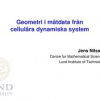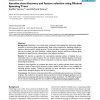7 search results - page 1 / 2 » Approximate geodesic distances reveal biologically relevant ... |
BIOINFORMATICS
2004
13 years 4 months ago
2004
BMCBI
2006
13 years 4 months ago
2006
Background: An alternative to standard approaches to uncover biologically meaningful structures in micro array data is to treat the data as a blind source separation (BSS) problem...
KDD
2004
ACM
13 years 10 months ago
2004
ACM
Many real-world graphs have been shown to be scale-free— vertex degrees follow power law distributions, vertices tend to cluster, and the average length of all shortest paths is...
BIOINFORMATICS
2007
13 years 5 months ago
2007
: Background Clustering algorithms are widely used in the analysis of microarray data. In clinical studies, they are often applied to find groups of co-regulated genes. Clustering...
BMCBI
2004
13 years 4 months ago
2004
Background: Clustering is one of the most commonly used methods for discovering hidden structure in microarray gene expression data. Most current methods for clustering samples ar...


